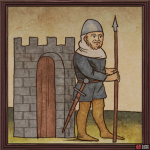Text
In medieval towns, law and order were maintained by the bailiff. From the 14th century, this role was taken over by the catchpole, and later by the night watchman and crier in town towers. The catchpole, along with the bailiff, executioner or their henchmen, also carried out punishments on offenders. However, they were not allowed to enter free houses (palaces and houses of nobles, rulers), church buildings, or universities, which students often exploited.
Order in the town had to be maintained by the townspeople themselves. They were required to report not only crimes but also, like the night watchmen, announce the time, and warn of fire, floods, or storms.
For safety reasons, it was forbidden to go to the castle, chambers, stables, barns, and byres at night with an open flame (torch or candle). Only lanterns were to be used. To maintain night peace, all taverns had to close after sunset.
In a medieval town, military service was performed either by hired professionals or by the town’s citizens themselves. Every healthy adult man was expected to serve in the town’s garrison for at least a few days a year. Different quarters or guilds had their own sections of the town walls to guard, and in the event of an alarm, the town’s defenders would gather at these sections.
In practice, wealthy townspeople would pay others to perform guard duties for them, hiring poorer men who saw this as a welcome source of income—thus gradually forming a professional town guard.
Each guard and town militia member provided their own armour and weapons, unless their guild provided it. Only wealthy towns could afford their own state armoury.
The right to bear arms outside of “service” was only granted to townspeople with a certain level of property. Inside the town walls, a simple stabbing weapon, dagger, or knife had to suffice. Only truly wealthy townspeople carried swords, following the example of the nobility.


No Comments